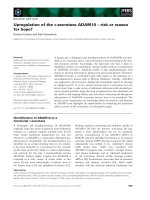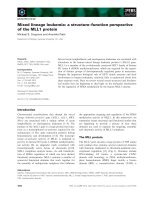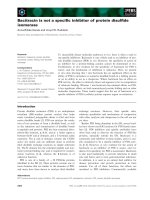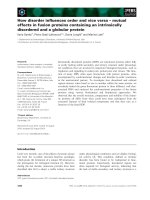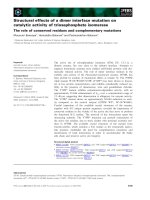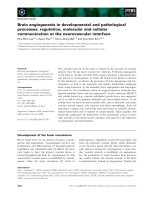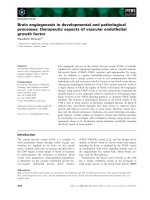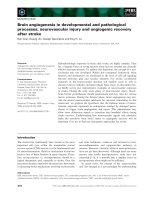Tài liệu Báo cáo khoa học: "Event Extraction in a Plot Advice Agent" doc
Bạn đang xem bản rút gọn của tài liệu. Xem và tải ngay bản đầy đủ của tài liệu tại đây (108.52 KB, 8 trang )
Proceedings of the 21st International Conference on Computational Linguistics and 44th Annual Meeting of the ACL, pages 857–864,
Sydney, July 2006.
c
2006 Association for Computational Linguistics
Event Extraction in a Plot Advice Agent
Harry Halpin
School of Informatics
University of Edinburgh
2 Buccleuch Place
Edinburgh, EH8 9LW
Scotland, UK
Johanna D. Moore
School of Informatics
University of Edinburgh
2 Buccleuch Place
Edinburgh, EH8 9LW
Scotland, UK
Abstract
In this paper we present how the auto-
matic extraction of events from text can
be used to both classify narrative texts ac-
cording to plot quality and produce advice
in an interactive learning environment in-
tended to help students with story writing.
We focus on the story rewriting task, in
which an exemplar story is read to the stu-
dents and the students rewrite the story in
their own words. The system automati-
cally extracts events from the raw text, for-
malized as a sequence of temporally or-
dered predicate-arguments. These events
are given to a machine-learner that pro-
duces a coarse-grained rating of the story.
The results of the machine-learner and the
extracted events are then used to generate
fine-grained advice for the students.
1 Introduction
In this paper we investigate how features of a text
discovered via automatic event extraction can be
used in both natural language understanding and
advice generation in the domain of narrative in-
struction. The background application is a fully
automated plot analysis agent to improve the writ-
ing of students could be used by current nar-
rative tutoring systems (Robertson and Wiemer-
Hastings, 2002). As shown by participatory de-
sign studies, teachers are interested in a plot anal-
ysis agent that can give online natural language
advice and many students enjoy feedback from an
automated agent (Robertson and Cross, 2003). We
use automatic event extraction to create a story-
independent automated agent that can both ana-
lyze the plot of a story and generate appropriate
advice.
1.1 The Story Rewriting Task
A task used in schools is the story rewriting task,
where a story, the exemplar story, is read to the
students, and afterwards the story is rewritten by
each student, providing a corpus of rewritten sto-
ries. This task tests the students ability to both
listen and write, while removing from the student
the cognitive load needed to generate a new plot.
This task is reminiscent of the well-known “War
of the Ghosts” experiment used in psychology for
studying memory (Bartlett, 1932) and related to
work in fields such as summarization (Lemaire et
al., 2005) and narration (Halpin et al., 2004).
1.2 Agent Design
The goal of the agent is to classify each of the
rewritten stories for overall plot quality. This
rating can be used to give “coarse-grained” gen-
eral advice. The agent should then provide “fine-
grained” specific advice to the student on how their
plot could be improved. The agent should be able
to detect if the story should be re-read or a human
teacher summoned to help the student.
To accomplish this task, we extract events that
represent the entities and their actions in the plot
from both the exemplar and the rewritten stories.
A plot comparison algorithm checks for the pres-
ence or absence of events from the exemplar story
in each rewritten story. The results of this algo-
rithm will be used by a machine-learner to clas-
sify each story for overall plot quality and provide
general “canned” advice to the student. The fea-
tures statistically shared by “excellent” stories rep-
resent the important events of the exemplar story.
The results of a search for these important events
in a rewritten story provides the input needed by
templates to generate specific advice for a student.
857
2 Corpus
In order to train our agent, we collected a corpus
of 290 stories from primary schools based on two
different exemplar stories. The first is an episode
of “The Wonderful Adventures of Nils” by Selma
Lagerloff (160 stories) and the second a re-telling
of “The Treasure Thief” by Herodotus (130 sto-
ries). These will be referred to as the “Adventure”
and “Thief” corpora.
2.1 Rating
An experienced teacher, Rater A, designed a rating
scheme equivalent to those used in schools. The
scheme rates the stories as follows:
1. Excellent: An excellent story shows that
the student has “read beyond the lines” and
demonstrates a deep understanding of the
story, using inference to grasp points that
may not have been explicit in the story. The
student should be able to retrieve all the im-
portant links, and not all the details, but the
right details.
2. Good: A good story shows that the student
understood the story and has “read between
the lines.” The student recalls the main events
and links in the plot. However, the student
shows no deep understanding of the plot and
does not make use of inference. This can of-
ten be detected by the student leaving out an
important link or emphasizing the wrong de-
tails.
3. Fair: A fair story shows that student has
listened to the story but not understood the
story, and so is only trying to repeat what they
have heard. This is shown by the fact that the
fair story is missing multiple important links
in the story, including a possibly vital part of
the story.
4. Poor: A poor story shows the student has had
trouble listening to the story. The poor story
is missing a substantial amount of the plot,
with characters left out and events confused.
The student has trouble connecting the parts
of the story.
To check the reliability of the rating scheme,
two other teachers (Rater B and Rater C) rated
subsets (82 and 68 respectively) of each of the cor-
pora. While their absolute agreement with Rater A
Class Adventure Thief
1 (Excellent) .231 .146
2 (Good) .300 .377
3 (Fair) .156 .292
4 (Poor) .313 .185
Table 1: Probability Distribution of Ratings
makes the task appear subjective (58% for B and
53% for C), their relative agreement was high, as
almost all disagreements were by one level in the
rating scheme. Therefore we use Cronbach’s α
and τ
b
instead of Cohen’s or Fleiss’ κ to take into
account the fact that our scale is ordinal. Between
Rater A and B there was a Cronbach’s α statistic
of .90 and a Kendall’s τ
b
statistic of .74. Between
Rater B and C there was a Cronbach’s α statis-
tic of .87 and Kendall’s τ
b
statistic of .67. These
statistics show the rating scheme to be reliable and
the distribution of plot ratings are given in Table 1.
2.2 Linguistic Issues
One challenge facing this task is the ungrammati-
cal and highly irregular text produced by the stu-
dents. Many stories consist of one long run-on
sentence. This leads a traditional parsing system
with a direct mapping from the parse tree to a se-
mantic representation to fail to achieve a parse on
35% percent of the stories, and as such could not
be used (Bos et al., 2004). The stories exhibit fre-
quent use of reported speech and the switching
from first-person to third-person within a single
sentence. Lastly, the use of incorrect spelling e.g.,
“stalk” for “stork” appearing in multiple stories
in the corpus, the consistent usage of homonyms
such as “there” for “their,” and the invention of
words (“torlix”), all prove to be frequent.
3 Plot Analysis
To automatically rate student writing many tutor-
ing systems use Latent Semantic Analysis, a vari-
ation on the “bag-of-words” technique that uses
dimensionality reduction (Graesser et al., 2000).
We hypothesize that better results can be achieved
using a “representational” account that explicitly
represents each event in the plot. These semantic
relationships are important in stories, e.g., “The
thief jumped on the donkey” being distinctly dif-
ferent from “The donkey jumped on the thief.”
What characters participate in an action matter,
since “The king stole the treasure” reveals a major
858
misunderstanding while “The thief stole the trea-
sure” shows a correct interpretation by the student.
3.1 Stories as Events
We represent a story as a sequence of events,
p
1
p
h
, represented as a list of predicate-
arguments, similar to the event calculus (Mueller,
2003). Our predicate-argument structure is a mini-
mal subset of first-order logic (no quantifiers), and
so is compatible with case-frame and dependency
representations. Every event has a predicate (func-
tion) p that has one or more arguments, n
1
n
a
.
In the tradition of Discourse Representation The-
ory (Kamp and Reyle, 1993), our current predi-
cate argument structure could be converted auto-
matically to first order logic by using a default
existential quantification over the predicates and
joining them conjunctively. Predicate names are
often verbs, while their arguments are usually, al-
though not exclusively, nouns or adjectives. When
describing a set of events in the story, a superscript
is used to keep the arguments in an event distinct,
as n
2
5
is argument 2 in event 5. The same argument
name may appear in multiple events. The plot of
any given story is formalized as an event structure
composed of h events in a partial order, with the
partial order denoting their temporal order:
p
1
(n
1
1
, n
2
1
, n
a
1
), , p
h
(n
2
h
, n
4
h
n
c
h
)
An example from the “Thief” exemplar story is
“The Queen nagged the king to build a treasure
chamber. The king decided to have a treasure
chamber.” This can be represented by an event
structure as:
nag(king, queen)
build(chamber)
decide(king)
have(chamber)
Note due the ungrammatical corpus we cannot at
this time extract neo-Davidsonian events. A sen-
tence maps onto one, multiple, or no events. A
unique name and closed-world assumption is en-
forced, although for purposes of comparing event
we compare membership of argument and predi-
cate names in WordNet synsets in addition to exact
name matches (Fellbaum, 1998).
4 Extracting Events
Paralleling work in summarization, it is hypothe-
sized that the quality of a rewritten story can be
defined by the presence or absence of “seman-
tic content units” that are crucial details of the
text that may have a variety of syntactic forms
(Nenkova and Passonneau, 2004). We further hy-
pothesize these can be found in chunks of the
text automatically identified by a chunker, and we
can represent these units as predicate-arguments in
our event structure. The event structure of each
story is automatically extracted using an XML-
based pipeline composed of NLP processing mod-
ules, and unlike other story systems, extract full
events instead of filling in a frame of a story script
(Riloff, 1999). Using the latest version of the
Language Technology Text Tokenization Toolkit
(Grover et al., 2000), words are tokenized and sen-
tence boundaries detected. Words are given part-
of-speech tags by a maximum entropy tagger from
the toolkit. We do not attempt to obtain a full parse
of the sentence due to the highly irregular nature
of the sentences. Pronouns are resolved using a
rule-based reimplementation of the CogNIAC al-
gorithm (Baldwin, 1997) and sentences are lem-
matized and chunked using the Cass Chunker (Ab-
ney, 1995). It was felt the chunking method would
be the only feasible way to retrieve portions of the
sentences that may contain complete “semantic
content units” from the ungrammatical and irregu-
lar text. The application of a series of rules, mainly
mapping verbs to predicate names and nouns to
arguments, to the results of the chunker produces
events from chunks as described in our previous
work (McNeill et al., 2006). The accuracy of our
rule-set was developed by using the grammatical
exemplar stories as a testbed, and a blind judge
found they produced 68% interpretable or “sen-
sible” events given the ungrammatical text. Stu-
dents usually use the present or past tense exclu-
sively throughout the story and events are usually
presented in order of occurrence. An inspection
of our corpus showed 3% of stories in our corpus
seemed to get the order of events wrong (Hick-
mann, 2003).
4.1 Comparing Stories
Since the student is rewriting the story using their
own words, a certain variance from the plot of the
exemplar story should be expected and even re-
warded. Extra statements that may be true, but
are not explicitly stated in the story, can be in-
ferred by the students. Statements that are true
but are not highly relevant to the course of the
859
plot can likewise be left out. Word similarity
must be taken into account, so that “The king is
protecting his gold” can be recognized as “The
pharaoh guarded the treasure.” Characters change
in context, as one character that is described as
the “younger brother” is from the viewpoint of his
mother “the younger son.” So, building a model
from the events of two stories and simply check-
ing equivalence can not be used for comparison,
since a wide variety of partial equivalence must be
taken into account.
Instead of using absolute measures of equiva-
lence based on model checking or measures based
on word distribution, we compare each story on
the basis of the presence or absence of events. This
approach takes advantage of WordNet to define
synonym matching and uses the relational struc-
ture of the events to allow partial matching of
predicate functions and arguments. The events
of the exemplar story are assumed to be correct,
and they are searched for in the rewritten story in
the order in which they occur in the exemplar. If
an event is matched (including using WordNet),
then in turn each of the arguments attempts to be
matched.
This algorithm is given more formally in Fig-
ure 1. The complete event structure from the ex-
emplar story, E, and the complete event structure
from the rewritten story R, with each individual
event predicate name labelled as e and r respec-
tively, and their arguments labelled as n in either
N
e
and N
r
. SYN(x) is the synset of the term x,
including hypernyms and hyponyms except upper
ontology ones. The results of the algorithm are
stored in binary vector F with index i. 1 denotes
an exact match or WordNet synset match, and 0 a
failure to find any match.
4.2 Results
As a baseline system LSA produces a similar-
ity score for each rewritten story by comparing it
to the exemplar, this score is used as a distance
metric for a k-Nearest Neighbor classifier (Deer-
wester et al., 1990). The parameters for LSA were
empirically determined to be a dimensionality of
200 over the semantic space given by the rec-
ommended reading list for American 6th graders
(Landauer and Dumais, 1997). These parameters
resulted in the LSA similarity score having a Pear-
son’s correlation of 520 with Rater A. k was
found to be optimal at 9.
Algorithm 4.1: PLOTCOMPARE(E, R)
i ← 0
f ← ∅
for e ∈ E
do for r ∈ R
do
if e = SYN(r)
then f
i
← 1
else f
i
← 0
for n
e
∈ N
e
do
for n
r
∈ N
r
do
if n
e
= SYN(n
r
)
then f
i
← 1
else f
i
← 0
i = i + 1
Figure 1: Plot Comparison Algorithm
Classifier Corpus Features % Correct
k-NN Adventure LSA 47.5
Naive Bayes Adventure PLOT 55.6
k-NN Thief LSA 41.2
Naive Bayes Thief PLOT 45.4
Table 2: Machine-Learning Results
The results of the plot comparison algorithm
were given as features to machine-learners, with
results produced using ten-fold cross-validation.
A Naive Bayes learner discovers the different sta-
tistical distributions of events for each rating. The
results for both the “Adventure” and “Thief” sto-
ries are displayed in Table 2. “PLOT” means the
results of the Plot Comparison Algorithm were
used as features for the machine-learner while
”LSA” means the similarity scores for Latent Se-
mantic Analysis were used instead. Note that the
same machine-learner could not be used to judge
the effect of LSA and PLOT since LSA scores are
real numbers and PLOT a set of features encoded
as binary vectors.
The results do not seem remarkable at first
glance. However, recall that the human raters had
an average of 56% agreement on story ratings, and
in that light the Naive Bayes learner approaches
the performance of human raters. Surprisingly,
when the LSA score is used as a feature in addition
to the results of the plot comparison algorithm for
the Naive Bayes learners, there is no further im-
provement. This shows features given by the event
860
Class 1 2 3 4
1 (Excellent) 14 22 0 1
2 (Good) 5 36 0 7
3 (Fair) 3 20 0 2
4 (Poor) 0 11 0 39
Table 3: Naive Bayes Confusion Matrix: “Ad-
venture”
Class Precision Recall
Excellent .64 .38
Good .40 .75
Fair .00 .00
Poor .80 .78
Table 4: Naive Bayes Results: “Adventure”
structure better characterize plot structure than the
word distribution. Unlike previous work, the use
of both the plot comparison results and LSA did
not improve performance for Naive Bayes, so the
results of using Naive Bayes with both are not re-
ported (Halpin et al., 2004).
The results for the “Adventure” corpus are in
general better than the results for the “Thief” cor-
pus. However, this is due to the “Thief” corpus
being smaller and having an infrequent number of
“Excellent” and “Poor” stories, as shown in Table
1. In the “Thief” corpus the learner simply col-
lapses most stories into “Good,” resulting in very
poor performance. Another factor may be that the
“Thief” story was more complex than the “Adven-
ture” story, featuring 9 characters over 5 scenes, as
opposed to the “Adventure” corpus that featured 4
characters over 2 scenes.
For the “Adventure” corpus, the Naive Bayes
classifier produces the best results, as detailed in
Table 4 and the confusion matrix in Figure 3. A
close inspection of the results shows that in the
“Adventure Corpus” the “Poor” and “Good” sto-
ries are classified in general fairly well by the
Naive Bayes learner, while some of the “Excel-
lent” stories are classified as correctly. A signifi-
cant number of both “Excellent” and most “Fair”
stories are classified as “Good.” The “Fair” cate-
gory, due to its small size in the training corpus,
has disappeared. No “Poor” stories are classified
as “Excellent,” and no “Excellent” stories are clas-
sified as “Poor.” The increased difficulty in distin-
guishing “Excellent” stories from “Good” stories
is likely due to the use of inference by “Excellent”
stories, which our system does not use. An inspec-
tion of the rating scale’s wording reveals the sim-
ilarity in wording between the “Fair” and “Good”
ratings. This may explain the lack of “Fair” sto-
ries in the corpus and therefore the inability of
machine-learners to recognize them. As given by
a survey of five teachers experienced in using the
story rewriting task in schools, this level of perfor-
mance is not ideal but acceptable to teachers.
Our technique is also shown to be easily
portable over different domains where a teacher
can annotate around one hundred sample stories
using our scale, although performance seems to
suffer the more complex a story is. Since the Naive
Bayes classifier is fast (able to classify stories in
only a few seconds) and the entire algorithm from
training to advice generation (as detailed below)
is fully automatic once a small training corpus has
been produced, this technique can be used in real-
life tutoring systems and easily ported to other sto-
ries.
5 Automated Advice
The plot analysis agent is not meant to give the
students grades for their stories, but instead use
the automatic ratings as an intermediate step to
produce advice, like other hybrid tutoring systems
(Rose et al., 2002). The advice that the agent can
generate from the automatic rating classification
is limited to coarse-grained general advice. How-
ever, by inspecting the results of the plot com-
parison algorithm, our agent is capable of giving
detailed fine-grained specific advice from the re-
lationships of the events in the story. One tutor-
ing system resembling ours is the WRITE sys-
tem, but we differ from it by using event struc-
ture to represent the information in the system,
instead of using rhetorical features (Burstein et
al., 2003). In this regards it more closely resem-
bles the physics tutoring system WHY-ATLAS, al-
though we deal with narrative stories of a longer
length than physics essays. The WHY-ATLAS
physics tutor identifies missing information in the
explanations of students using theorem-proving
(Rose et al., 2002).
5.1 Advice Generation Algorithm
Different types of stories need different amounts
of advice. An “Excellent” story needs less ad-
vice than a “Good” story. One advice statement is
“general,” while the rest are specific. The system
861
produces a total of seven advice statements for a
“Poor” story, and two less statements for each rat-
ing level above “Poor.”
With the aid of a teacher, a number of “canned”
text statements offering general advice were cre-
ated for each rating class. These include state-
ments such as “It’s very good! I only have a few
pointers“ for a “Good” story and “Let’s get help
from the teacher” for “Poor” story. The advice
generation begins by randomly selecting a state-
ment suitable for the rating of the story. Those
students whose stories are rated “Poor” are asked
if they would like to re-read the story and ask a
teacher for help.
The generation of specific advice uses the re-
sults of the plot-comparison algorithm to produce
specific advice. A number of advice templates
were produced, and the results of the Advice Gen-
eration Algorithm fill in the needed values of the
template. The φ most frequent events in “Excel-
lent” stories are called the Important Event Struc-
ture, which represents the “important” events in
the story in temporal order. Empirical experiments
led us φ = 10 for the “Adventure” story, but for
longer stories like the “Thief” story a larger φ
would be appropriate. These events correspond to
the ones given the highest weights by the Naive
Bayes algorithm. For each event in the event struc-
ture of a rewritten story, a search for a match in
the important event structure is taken. If a pred-
icate name match is found in the important event
structure, the search continues to attempt to match
the arguments. If the event and the arguments do
not match, advice is generated using the structure
of the “important” event that it cannot find in the
rewritten story.
This advice may use both the predicate name
and its arguments, such as “Did the stork fly?”
from fly(stork). If an argument is missing, the ad-
vice may be about only the argument(s), like “Can
you tell me more about the stork?” If the event is
out of order, advice is given to the student to cor-
rect the order, as in “I think something with the
stork happened earlier in the story.”
This algorithm is formalized in Figure 2, with
all variables being the same as in the Plot Anal-
ysis Algorithm, except that W is the Important
Event Structure composed of events w with the
set of arguments N
w
. M is a binary vector used
to store the success of a match with index i. The
ADV function, given an event, generates one ad-
Algorithm
5.1: ADVICEGENERATE(W, R)
for w ∈ W
do
M = ∅
i = 0
for r ∈ R
do
if w = r or SY N(r)
then m
i
= 1
else m
i
= 0
i = i + 1
for n
w
∈ N
w
do
for n
r
∈ N
r
do
if n
w
= SYN(n
r
) or n
r
then m
i
← 1
else m
i
← 0
i = i + 1
ADV (w, M)
Figure 2: Advice Generation Algorithm
vice statement to be given to the student.
An element of randomization was used to gen-
erate a diversity of types of answers. An ad-
vice generation function (ADV ) takes an impor-
tant event (w) and its binary matching vector (M)
and generates an advice statement for w. Per im-
portant event this advice generation function is pa-
rameterized so that it has a 10% chance of deliver-
ing advice based on the entire event, 20% chance
of producing advice that dealt with temporal or-
der (these being parameters being found ideal af-
ter testing the algorithm), and otherwise produces
advice based on the arguments.
5.2 Advice Evaluation
The plot advice algorithm is run using a randomly
selected corpus of 20 stories, 5 from each plot rat-
ing level using the “Adventure Corpus.” This pro-
duced matching advice for each story, for a total
of 80 advice statements.
5.3 Advice Rating
An advice rating scheme was developed to rate the
advice produced in consultation with a teacher.
1. Excellent: The advice was suitable for the
story, and helped the student gain insight into
the story.
2. Good: The advice was suitable for the story,
862
Rating % Given
Excellent 0
Good 35
Fair 60
Poor 5
Table 5: Advice Rating Results
and would help the student.
3. Fair: The advice was suitable, but should
have been phrased differently.
4. Poor: The advice really didn’t make sense
and would only confuse the student further.
Before testing the system on students, it was de-
cided to have teachers evaluate how well the ad-
vice given by the system corresponded to the ad-
vice they would give in response to a story. A
teacher read each story and the advice. They then
rated the advice using the advice rating scheme.
Each story was rated for its overall advice quality,
and then each advice statement was given com-
ments by the teacher, such that we could derive
how each individual piece of advice contributed
to the global rating. Some of the general “coarse-
grained” advice was “Good! You got all the main
parts of the story” for an “Excellent” story, “Let’s
make it even better!” for a “Good” story, and
“Reading the story again with a teacher would be
help!” for a “Poor” story. Sometimes the ad-
vice generation algorithm was remarkably accu-
rate. In one story the connection between a curse
being lifted by the possession of a coin by the
character Nils was left out by a student. The ad-
vice generation algorithm produced the following
useful advice statement: “Tell me more about the
curse and Nils.” Occasionally an automatically ex-
tracted event that is difficult to interpret by a hu-
man or simply incorrectly is extracted. This in turn
can cause advice that does not make any sense
can be produced, such as “Tell me more about a
spot?”. Qualitative analysis showed that “missing
important advice” to be the most significant prob-
lem, followed by “nonsensical advice.”
5.4 Results
The results are given in Table 5. The majority of
the advice was rated overall as “fair.” Only one
story was given “poor” advice, and a few were
given “good” advice. However, most advice rated
as “good” was the advice generated by “excel-
lent” stories, which generate less advice than other
types of stories. “Poor” stories were given almost
entirely “fair” advice, although once “poor” ad-
vice was generated. In general, the teacher found
“coarse-grained” advice to be very useful, and was
very pleased that the agent could detect when the
student needed to re-read the story and when a stu-
dent did not need to write any more. In some cases
the specific advice was shown to help provide a
“crucial detail” and help “elicit a fact.” The advice
was often “repetitive” and ”badly phrased.” The
specific advice came under criticism for often not
“being directed enough” and for being “too literal”
and not “inferential enough.” The rater noticed
that “The program can not differentiate between
an unfinished story and one that is confused.” and
that “Some why, where and how questions could
be used” in the advice.
6 Conclusion and Future Work
Since the task involved a fine-grained analysis of
the rewritten story, the use of events that take plot
structure into account made sense regardless of
its performance. The use of events as structured
features in a machine-learning classifier outper-
formed a classifier that relied on a unstructured
“bag-of-words” as features. The system achieved
close to human performance on rating the stories.
Since each of the events used as a feature in the
machine-learner corresponds to a particular event
in the story, the features are easily interpretable by
other components in the system and interpretable
by humans. This allows these events to be used
in a template-driven system to generate advice for
students based on the structure of their plot.
Extracting events from text is fraught with er-
ror, particularly in the ungrammatical and infor-
mal domain used in this experiment. This is often
a failure of our system to detect semantic content
units through either not including them in chunks
or only partially including a single unit in a chunk.
Chunking also has difficulty dealing with preposi-
tions, embedded speech, semantic role labels, and
complex sentences correctly. Improvement in our
ability to retrieve semantics would help both story
classification and advice generation.
Advice generation was impaired by the abil-
ity to produce directed questions from the events
using templates. This is because while our sys-
tem could detect important events and their or-
863
der, it could not make explicit their connection
through inference. Given the lack of a large-scale
open-source accessible “common-sense” knowl-
edge base and the difficulty in extracting infer-
ential statements from raw text, further progress
using inference will be difficult. Progress in ei-
ther making it easier for a teacher to make explicit
the important inferences in the text or improved
methodology to learn inferential knowledge from
the text would allow further progress. Tantaliz-
ingly, this ability for a reader to use “inference to
grasp points that may not have been explicit in the
story” is given as the hallmark of truly understand-
ing a story by teachers.
References
Steven Abney. 1995. Chunks and dependencies:
Bringing processing evidence to bear on syntax. In
Jennifer Cole, Georgia Green, and Jerry Morgan,
editors, Computational Linguistics and the Founda-
tions of Linguistic Theory, pages 145–164.
Breck Baldwin. 1997. CogNIAC : A High Precision
Pronoun Resolution Engine.
F.C. Bartlett. 1932. Remembering. Cambridge Uni-
versity Press, Cambridge.
Johan Bos, Stephen Clark, Mark Steedman, James Cur-
ran, and Julia Hockenmaier. 2004. Wide-coverage
semantic representations from a CCG parser. In In
Proceedings of the 20th InternationalConference on
Computational Linguistics (COLING ’04). Geneva,
Switzerland.
Jill Burstein, Daniel Marcu, and Kevin Knight. 2003.
Finding the WRITE Stuff: Automatic Identification
of Discourse Structure in Student Essays. IEEE In-
telligent Systems, pages 32–39.
S. Deerwester, S. T. Dumais, G. W. Furnas, T. K. Lan-
dauer, and R Harshman. 1990. Indexing by Latent
Semantic Analysis. Journal of the American Society
For Information Science, (41):391–407.
Christine Fellbaum. 1998. WordNet: An Electronic
Lexical Database. MIT Press, Cambridge, MA.
A. Graesser, P. Wiemer-Hastings, K. Wiemer-Hastings,
D. Harter, and N. Person. 2000. Using latent se-
mantic analysis to evaluate the contributions of stu-
dents in autotutor. Interactive Learning Environ-
ments, 8:149–169.
Claire Grover, Colin Matheson, Andrei Mikheev, and
Marc Moens. 2000. LT TTT - A Flexible Tokenisa-
tion Tool. In Proceedings of the Second Language
Resources and Evaluation Conference.
Harry Halpin, Johanna Moore, and Judy Robertson.
2004. Automatic analysis of plot for story rewriting.
In In Proceedings of Empirical Methods in Natural
Language Processing, Barcelona, Spain.
Maya Hickmann. 2003. Children’s Discourse: per-
son, space and time across language. Cambridge
University Press, Cambridge, UK.
Hans Kamp and Uwe Reyle. 1993. From Discourse to
Logic. Kluwer Academic.
Thomas. Landauer and Susan Dumais. 1997. A solu-
tion to Plato’s problem: The Latent Semantic Anal-
ysis theory of the acquisition, induction, and repre-
sentation of knowledge. Psychological Review.
B. Lemaire, S. Mandin, P. Dessus, and G. Denhire.
2005. Computational cognitive models of summa-
rization assessment skills. In In Proceedings of the
27th Annual Meeting of the Cognitive Science Soci-
ety, Stressa, Italy.
Fiona McNeill, Harry Halpin, Ewan Klein, and Alan
Bundy. 2006. Merging stories with shallow seman-
tics. In Proceedings of the Knowledge Representa-
tion and Reasoning for Language Processing Work-
shop at the EuropeanAssociation for Computational
Linguistics, Genoa, Italy.
Erik T. Mueller. 2003. Story understanding through
multi-representation model construction. In Graeme
Hirst and Sergei Nirenburg, editors, Text Meaning:
Proceedings of the HLT-NAACL 2003 Workshop,
pages 46–53, East Stroudsburg, PA. Association for
Computational Linguistics.
Ani Nenkova and Rebecca Passonneau. 2004. Evalu-
ating content selection in summarization: The pyra-
mid method. In In Proceedings of the Joint Con-
ference of the North American Association for Com-
putational Linguistics and Human Language Tech-
nologies. Boston, USA.
E. Riloff. 1999. Information extraction as a step-
ping stone toward story understanding. In Ash-
win Ram and Kenneth Moorman, editors, Computa-
tional Models of Reading and Understanding. MIT
Press.
Judy Robertson and Beth Cross. 2003. Children’s
perceptions about writing with their teacher and the
StoryStation learning environment. Narrative and
Interactive Learning Environments: Special Issue
of International Journal of Continuing Engineering
Education and Life-long Learning.
Judy Robertson and Peter Wiemer-Hastings. 2002.
Feedback on children’s stories via multiple interface
agents. In International Conference on Intelligent
Tutoring Systems, Biarritz, France.
C. Rose, D. Bhembe, A. Roque, S. Siler, R. Srivas-
tava, and K. VanLehn. 2002. A hybrid language
understandingapproach for robust selection of tutor-
ing goals. In International Conference on Intelligent
Tutoring Systems, Biarritz, France.
864

